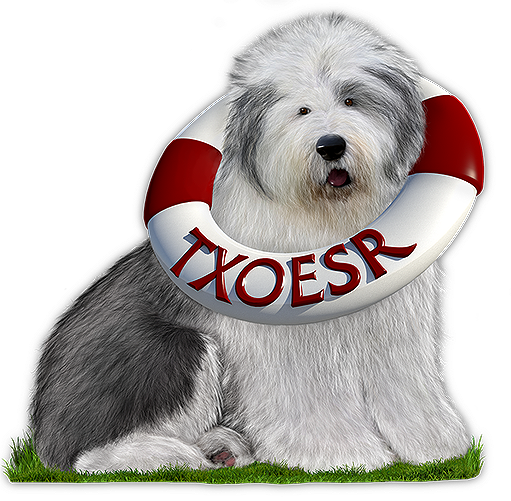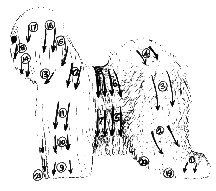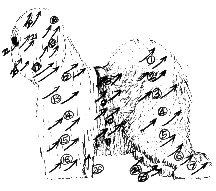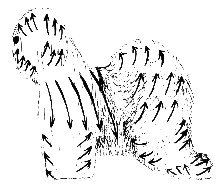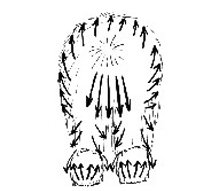Important Links
Historical origins of the Old English Sheepdog are obscure but it is thought to be a combination of the Scottish Bearded Collie and the South Russian Owtchar.
The Old English Sheepdog breed has been around since at least the 1800's and achieved official breed status in 1873 with the founding of The Kennel Club in England.
The first Old English Sheepdog came to North America around 1885 and achieved official breed status with the American Kennel Club in 1888.
In the early 1900's, the Old English Sheepdog made its way into the hearts of people across most of Europe
The OES, also known as the Bobtail, had their tail 'docked' or 'bobbed' to signify that they were working dogs and therefore were exempt from taxes. Today the tail continues to be docked to preserve the tradition of the breed.
BRING YOUR DOG HOME
BEFORE GOING INSIDE YOUR HOME
Take your dog for a long walk around your neighborhood and around your yard. This lets your new dog know where he is and he won’t be uncomfortable inside “the walls”.
IF YOU HAVE OTHER DOGS .... Introduce your animals to each other outside your home. Dogs are territorial and may be aggressively defensive. Meeting outside their territory lets them become acquainted in a neutral area. Take them all for a walk together before going inside.
FIRST TIME INSIDE THE HOUSE .... Show your dog around the house under control of a leash. Then let the dog off the leash to explore the house on his or her own.
TALK TO YOUR DOG .... Let your dog get to know you by talking to him or her in full sentences in a friendly voice. Say your dog’s name often.
FEEDING …. Large breeds need to eat twice a day. A very small meal in the morning and the larger meal in the evening. Always take the dog for a walk immediately after they eat. They need to go “potty” after each meal. That’s just the way a dog’s digestive system works.
ACCIDENT IN THE HOUSE .... The dog may have an “accident” in the first day or two because he doesn’t yet know the allowable place to go. Take the dog outside and stay with him until he goes. Then praise him.
REGULAR SCHEDULE …. Your new family member doesn’t like surprises. Eating time, eating area, sleeping and going outside time. Establish a reasonable schedule and stick to it.
TETHER AT NIGHT …. (Optional) If your new family member is restless at bedtime, use a short tether next to your bed. Your dog wants to be where you are. If you use a tether for the first two or three days, the dog will not be tempted to have an “accident” and will become accustomed to where he or she should be.
MOST OF ALL – LOVE YOUR DOG …. Everything is new and your new family member is scared. If you build a trust and friendship, your dog will do anything for you. Unlike popular belief, your dog does not think of himself as a person – he thinks of you as another dog.
FAQ
- TXOESR pays for all vetting
- TXOESR does NOT support the use of any shock collar or prong collar of ANY kind
- Dogs are NEVER left outside while no one is home
- Dogs are NEVER left unattended around a swimming pool
- Dogs are never sent away to a board and train facility
- Foster families will have the first option to adopt their foster dog
- TXOESR will handle all contracts and money transactions
- Foster families do not have the authority to arrange for a dog to be left at a potential owners home
- Foster families do not have the authority to adopt out a dog to a potential owner
- TXOESR will make all final adoption decisions
- Spaying & Neutering
All adult dogs will be spayed or neutered once settled in the foster home. No puppies are to be spayed or neutered until they are at least one year old (male) or when the female has completed her second cycle. It is much healthier for the dog to be altered once they have matured. Owners will sign an agreement to our terms.
TOP 12 TOXINS IN THE KITCHEN
- Unbaked bread
- Dough/Alcohol
- Grapes & Raisins
- Xylitol/Sugar-Free
- Gum/Candy
- Onions & Garlic
- Human Medications
- Compost
- Fatty Table Scraps
- Macadamia Nuts
- Household Cleaners
- Chocolate
MAINTENANCE
DAILY
- Clean away any "sand man" deposits from eyes.
- Reason: If the deposits are not cleared away from the skin, the moisture will attract bacteria. Bacteria will produce an infection, and a trip to the veterinarian will be in order.
- Check hair around eyes to see if there is any debris caught in the hair. Reason: If there is a leaf or small twig, etc. caught in the hair, the sheepdog cannot, because of the density of the hair, remove it by pawing at it. If anything is rubbing on the eye, this can produce lacerations on the eyeball. A trip to a veterinarian specializing in ophthalmology will have to be made.
- Fresh food and water.
- Water at all times!!!! Good dry kibble. The best diet you can give your dog is a good dry kibble food!!! No human food!!! No changes from brand to brand!!! Any change in food with a sheepdog usually means instant diarrhea!!!! Reason: Your dog deserves it. Diarrhea will dehydrate your dog and can decrease its immunity to fight off colds, and diseases. Meanwhile, who needs to clean up the mess, especially when you've come home from a hard day at the office!
WEEKLY
- Complete de-matting of the entire dog. This can be done, within a reasonable time, by doing the following:
- Comb (with the grain), using a mat splitting comb, until you have broken up all the mats. Pay particular attention to behind the ears, the chest, under the stomach, and the rear.
- Then use a medium or small Universal or small Warners slicker to remove the broken up mats. If the hair is 4 inches or less, you can brush with the grain. If the hair is longer than 4 inches, you must brush against the grain. You must be able to see the skin!
- After the first two bullets, you should be able to pass a medium tooth comb through the hair; if not, start over.
- Reason: If anything gets underneath the mat (flea, tick, parasite, etc.), the density of the coat, does not allow the dog to be able to get it. In most cases, the dog will try to remove it, but will only inflict damage to it's own skin. This can cause "hotspots", and must be treated by a veterinarian. Hotspots that are not treated promptly can attract flies looking for a warm moist place to lay eggs - hence maggots which can be fatal.
MONTHLY
Heartworm prevention pill.
Reason: An ounce of prevention is worth a pound of cure.
QUARTERLY
Note: You may wish to have all of the items below done by a groomer. They are listed here so that you will know what must be done, and can pass this information on to your groomer. Do not assume that all groomers know how to groom an Old English Sheepdog!
SEMI ANNUALLY
Shave/Strip:
- If desired, shave with a number 4 blade all over. This can be done in the spring, and fall of the year. Or,
- Puppy cut by hand to 1 1/2 or 2 inches.
- Reason: Maintenance will be much easier! Possible skin problems or growths can be seen, and treated. On certain Old English Sheepdogs this can be done more often because of skin problems or ease of maintenance. Note: Some diehards prefer to keep the hair long all year. These people don't have to work or they have no time for any social life at all!
ANNUALLY
Veterinarian visit: (You finally get to go - again!)
- General physical
- Heartworm check (occult)
- Internal parasite check (bring stool sample)
- Distemper-hepatitis-leptos pirosis-parainfluenza-parvo virus- vaccination
- Bordetella inoculation
- Rabies vaccination
- One year supply of heartworm pills. Reason: Most health problems that are caught in the early stages are easily treatable. Many kennels will not accept a dog unless it has had the bordatella immunization 2 weeks before boarding! (Also, giving heartworm year round may also appear to be excessive, but if you have to go to Florida with your dog in the middle of January, do you really want to worry about heartworm?)
As you can see, owning an Old English Sheepdog is very time consuming, costly, or both. If you have neither the time nor the finances to maintain this dog, the consequences described above are what you can expect to happen.
- First, the dog will become matted.
- Followed by feces stuck to the rear end.
- Followed by smelling like a barn.
- Followed by removal from your house.
- Followed by being tied outside.
- Followed by your feeling guilty that it is not fair to the dog.
- Followed by your giving the dog up to someone or someplace.
- Followed by your children crying and not understanding why doggie must go.
These notes are provided as an aid, particularly for novice groomers. There are many ways of grooming the OES and clearly everyone adopts their own style as they gain experience over the years. I have indeed been fortunate to learn from several fellow exhibitors over my 18 years of experience with the breed, which I now hope to share with you through the following hints/tips. For convenience I have divided the notes in to 3 main sections covering:
- Pet grooming
- Show grooming
- Ring presentation
Hopefully by dividing the notes in this way you will be able to extract the relevant section to suit your needs. Diagrams have been included to help illustrate the techniques described, and I am grateful to Bertie Pennie for drawing them.
GROOMING
CRATE TRAINING
CRATE TRAINING
There are many wonderful reasons to buy a crate for your new dog.
At the top of the list are his security and your peace of mind.
- A crate is your dog's little den. Do you remember building a playhouse out of a huge box when you were a kid? You had fun in that little enclosure. You felt safe. The crate is your dog's playhouse.
- Choose a size of crate that you'll be able to use for your dog when he is a fully grown adult. The full-grown dog must be able to stand, sit, turn around and lie down comfortably. Hopefully, your dog has come from a breeder or foster home who crate trained it or started crate training it. In that case, this dog already considers a crate it's home.
Crate training a dog is important for a number of reasons.
- It will keep him out of trouble and makes him feel more secure about being left alone
- If you have visitors who are afraid of dogs or service people working in the house, the crate will keep your dog from getting underfoot.
- A crated dog cannot destroy your home. He cannot chew on an electrical cord and electrocute himself. He cannot find that bug poison you sprinkled under the bathroom sink and forgot about. He cannot got into the cleaning chemicals under your sink when you are not watching.
- A dog's natural instinct is to chew, especially when he is teething. Just like a baby he will put anything into his mouth. Anything within the dog's potential range is a target. You wouldn't let a toddler run unsupervised in your home and help himself to anything. You shouldn't do it with a dog, either.
- A crate is also where he learns to control his bladder and piddle outside. Dogs will usually make a great effort not to soil their den. If you take your dog out often, and praise him highly for doing his business outside, with the crate's help, he will housebreak sooner, with fewer accidents.
- A crate is also a good way to keep your relationship with your dog positive. After all, if the little guy isn't running through the house, he cannot be doing things he shouldn't do. You come home, he's wagging his rear. You tell him he's great, calmly open the crate door and immediately take him outside. He relieves himself and you tell him he is wonderful. Lots of positive reinforcement here. There is no need for yelling and screaming when you get home to find he has trashed the house. There is no way he could trash the house, as he was safely confined to this crate.
If your dog has never seen a crate, introduce him to his new home slowly when he needs to take a nap. After he eats, he will want to relieve himself. After that, put him in the crate for nap time.
- When the dog wakes up, he will bark because he needs to go out and doesn't want to soil his bed. Take him out, let him piddle, play with him for awhile. When he is tired and ready for another nap, put him back in the crate. The crate is like a baby's crib--it is a safe place to sleep, but is not the proper place for bathroom functions.
- Your dog may start to whine or bark when he is locked in the crate. This is normal. The dog may be trying to tell you he has to go. If you are sure he doesn't need to relieve himself, ignore him. Some dogs will only fuss for a few minutes, others may bark for a while.
- To make your dog more comfortable in his crate, put a washable, fluffy towel on the crate floor (don't use newspapers in the crate--this will only confuse the dog about the proper place to relieve himself). Put in a safe chew toy like a Kong or a Nylabone to keep him occupied.
It is also a great safety measure when traveling with your dog. A crate will also prevent the dog from jumping all over you while you are driving, causing an accident. Keeping an animal crated during travel also offers the dog added security in the event of an automobile accident. If you don't want to crate your dog during travel, pet stores now have safety belts for dogs.
Once you reach your destination, a crate provides your dog with a safe haven in a strange location. It makes you a more welcome guest since your dog won't be running wild through someone else's home or in the motel room. He'll be happier because he has his 'den,' your host will be happier since he'll have no accidents and you'll be happier because you won't have to apologize for puddles and ripped furniture.
The crate is not a place for punishment. It should always be seen by your dog as a wonderful, happy haven.
If you approach the crate as a necessity of dog ownership similar to the leash, collar and water bowl, your dog will accept it readily. It will become his little home. You won't have to worry about what he is doing when you aren't watching. And he is feeling safe while you are gone because he is in his den.
